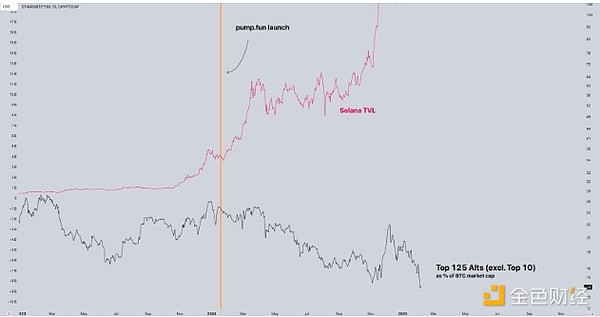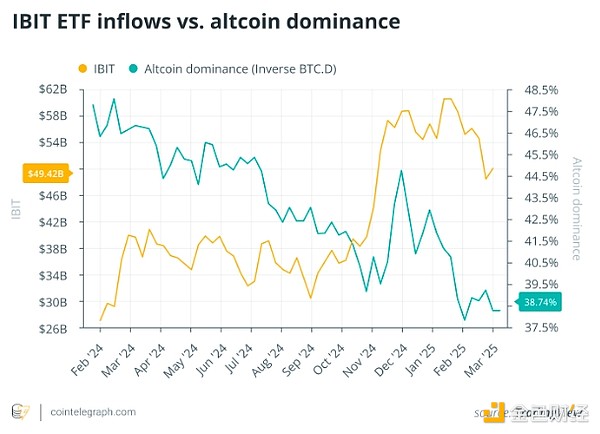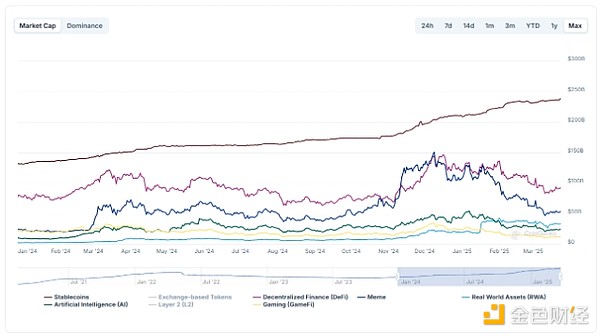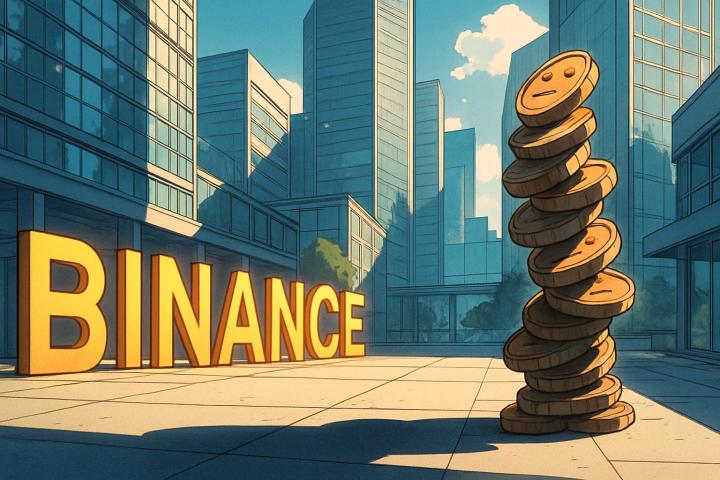Author: Marie Poteriaieva, CoinTelegraph; Translated by: Deng Tong, Jinse Finance
In crypto, few things are as elusive and misunderstood as the concept of an “Altcoin season.” Traditionally, the term refers to a brief window (usually 2-3 months) following a Bitcoin (BTC) price rally during which Altcoin experience cumulative returns that exceed BTC. This pattern persisted in the 2015-2018 and 2019-2022 cycles, but the jury is still out on whether the current bull run has ushered in an Altcoin season.
Blockchain Center defines an Altcoin season as one in which 75% of the top 50 Altcoin outperform Bitcoin over a rolling 90-day timeframe. Its Altcoin season index saw rallies in both March 2024 and January 2025, but neither rally lasted long enough to qualify as a full-fledged Altcoin season.

Altcoin Seasonal Index. Source: Blockchain Center
Some analysts believe that meme coins drain liquidity from the broader Altcoin market. Others blame the oversaturation of crypto investment products (especially ETFs) that cater to institutions and focus only on the largest Altcoin. A third explanation requires a deeper rethinking of what Altcoin actually are. In this view, Altcoin are viewed as a unified asset class, but are actually a diverse collection of crypto assets with different functions, value structures, and growth potential.
Memecoin in the spotlight
For cryptocurrency analyst Miles Deutscher, the launch of Pump.fun is directly related to the collapse of the Altcoin market relative to BTC.
“The reason we didn’t see a major ‘Altcoin season’ across major markets is that the speculative capital that once poured into the top 200 assets decided to rush into lower-cap on-chain assets first.”
Deutscher noted that early investors and insiders made a fortune as a result, but most retail investors who entered later lost money. This was also the case with previous Altcoin cycles. However, unlike in 2022, the losses were mainly limited to liquid CEX Altcoin, while they were trapped in illiquid on-chain memecoins, which quickly retraced 70%-80%. This led to a "wealth destruction event (LUNA excluded) that was "worse than the early 2022 bear market", even though BTC (and some major currencies) were still in a macro bull trend.

Solana TVL vs. top 125 Altcoin(excluding top 10). Source: Miles Deutscher
Political factors in the United States have also fueled the memecoin craze. For example, President Donald Trump’s public support for memecoins sparked a craze, but the results were soon disappointing. Since their launch in late January, TRUMP and MELANIA tokens have fallen 83% and 95% respectively, once again hitting retail sentiment.
Institutional investors and ETFs turn the tide
Another factor influencing the strength of the current bullish Altcoin season is Wall Street’s involvement. The January 2024 launch of the spot Bitcoin ETF brought in $129 billion in inflows as investors flocked to the familiar custody, regulation, and easy-to-access structure. BlackRock’s IBIT became the dominant tool, and the July 2024 launch of ETF options added depth.
Some analysts believe that the security and scalability of spot BTC ETFs have siphoned capital away from speculative assets. With the ability to hedge through options and futures, the incentive to gamble on illiquid, low-volume Altcoin is greatly reduced.

But this explanation has its limits. Cryptocurrency is not a zero-sum market — global liquidity is growing, and capital entering the space can flow in multiple directions. If anything, institutional demand could expand the total volume of cryptocurrencies.
In addition, some Altcoin already have their own ETFs. According to CoinGlass, the spot Ethereum ETF debuted in July 2024 and has since seen modest net inflows of $565,000. Such a large difference in size from the spot BTC ETF shows that ETF structure alone is not enough; investor conviction still matters.
The function of Altcoin and their rallies have become more nuanced
The term “Altcoin” came about when any non-Bitcoin token was new. But in today’s ecosystem, the term lumps together vastly different assets: blockchain native tokens, governance tokens, stablecoins, meme coins, DApp tokens, and real-world asset protocol tokens — each with different functionalities and investor profiles. Just as it doesn’t make sense to group gold, Nvidia stock, and the U.S. dollar into one index in traditional finance, it doesn’t make sense to think of all Altcoin as one unified category.
A closer look at price action supports this idea. According to Coingecko, major Altcoin categories have diverged sharply this cycle. Real World Asset (RWA) tokens have surged 15x. In contrast, GameFi’s market cap has halved. This suggests that narratives are playing an increasing role in driving investors’ capital allocation decisions.

Market capitalization by cryptocurrency category. Source: CoinGecko
Even core blockchain tokens are beginning to specialize. Ethereum remains at the center of DeFi. Solana dominates memecoins. Tron is now #2 in stablecoin transfers. ImmutableX is carving out a niche in gaming. In each case, token performance is increasingly tied to ecosystem activity. This means we might want to move away from the term “Altcoin season” and start paying more attention to specific narratives within the crypto space.
This may be the biggest sign of the crypto market’s maturity.







